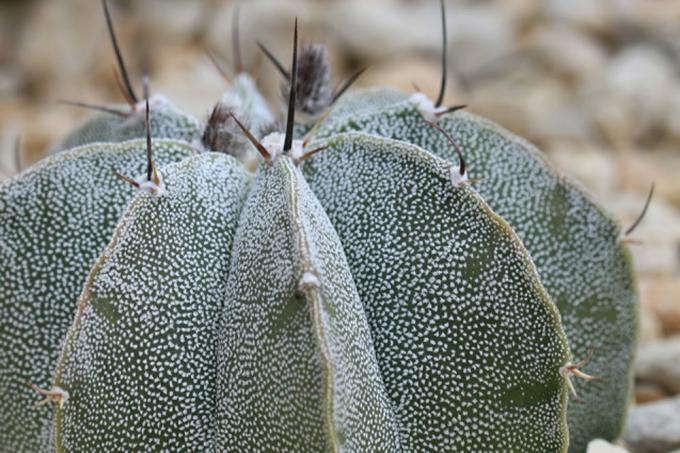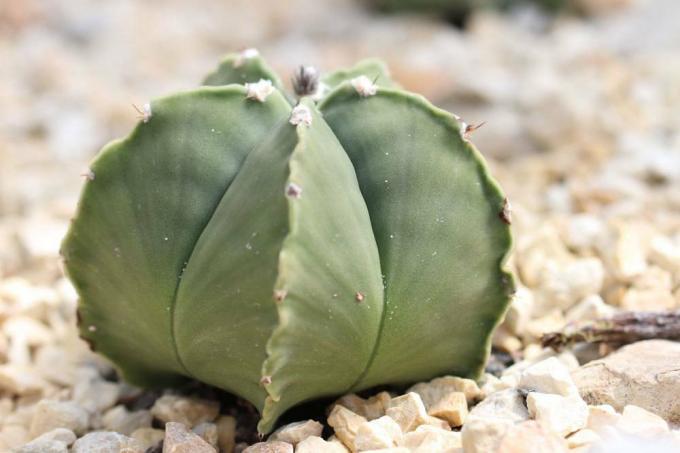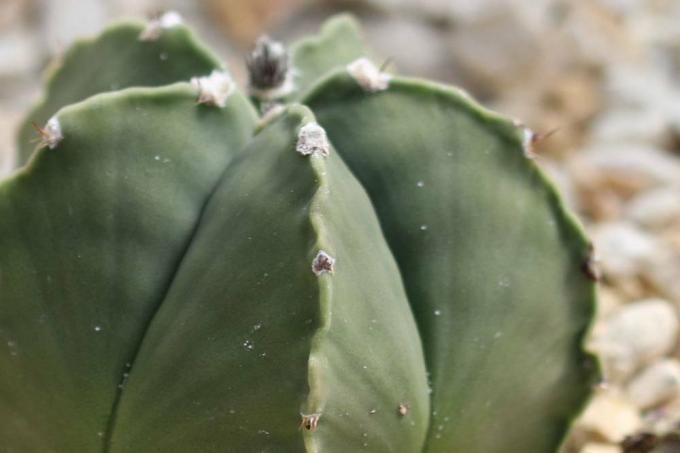
table of contents
- care
- Location
- floor
- Planting / transplanting
- to water
- Fertilize
- Multiply
- Diseases
- Pests
Profile and care information open +conclude -
- Flower color
- yellow
- Location
- Sunny
- Heyday
- March, April, May, June, July, August, September, October
- Growth habit
- upright, bushy
- height
- up to 25 centimeters high
- Soil type
- sandy, gritty
- Soil moisture
- very dry
- PH value
- neutral, weakly alkaline
- Limescale tolerance
- Calcium intolerant
- humus
- low in humus
- Poisonous
- no
- Plant families
- Cactus family, Cactaceae
- Plant species
- Houseplants
- Garden style
- Ornamental garden
The bishop's cap (Astrophytum myriostigma) is a cactus plant with special properties. Spherical as a young plant, it takes on a cylindrical shape at the age of two. The spherical shape is very reminiscent of bishop's hats, hence the name. This cactus has no spines, but is covered with tiny, silvery flakes of wool. After three years at the earliest, bright yellow-red 5 - 7 cm flowers crown it continuously from March to October.
care
Among the numerous types of cactus, the bishop's cap, named after a traditional headgear, the miter, is a real gem, not least because of its unusual appearance. In addition, it is rarely found in its natural habitat. Compared to other plant species, the care of the star cactus is a little more demanding. It can only develop optimally and produce flowers if its care requirements are met.

Location
The bishop's hat Astrophytum myriostigma should be warm and as sunny as possible, ideally in a south-facing window and no further than 30 cm from the window pane. It should be at least 4 hours of sun a day, ideally in the morning and afternoon. Nevertheless, the blazing midday sun should be weakened a little, especially in summer, for example by a curtain.
During the summer it can easily stand outdoors in a sunny place protected from midday sun and rain. In terms of temperature, this cactus needs normal living space temperatures between 18 and 25 degrees during the main growth, from spring to late autumn, both during the day and at night. Only in winter does he like it a little cooler.
floor
In order to thrive, the Bonete de Obispo cactus needs a purely mineral substrate. This can be a purely mineral cactus soil or a mixture of commercially available potting soil and mineral components such as lavalite, pumice gravel or lava granules as well as some quartz sand (lime-free Sand).
The Bischofsmütze also thrives very well in a mixture of two parts of culture soil based on peat or compost and one part of perlite or sharp sand. Very nutrient-rich and pre-fertilized potting soil from the trade or from the garden as well as humus and conventional building sand are completely unsuitable. Some cactus nurseries also offer special ready-made mixtures for astrophytes.
Tip: With the mixing ratio, care must be taken that the final mixture is neither too tight nor too loose. If the substrate is too loose, the roots find it difficult to hold onto and irrigation water flows off immediately and cannot be stored. On the other hand, the roots cannot develop or develop properly in a substrate that is too firm. not spread.
Planting / transplanting
The bishop's cap is a cactus that does not have to be replanted every year. Smaller specimens can usually be cultivated in 8 cm pots for several years. Nevertheless, you should occasionally lift it out of the pot briefly in spring to see whether it is already deeply rooted. If this is the case, they can be transplanted into a slightly larger pot. If you wait too long and the pot is already too narrow, the plant can no longer develop optimally.

When choosing a planter, clay pots are preferable to those made of plastic. Clay pots have the advantage that they evaporate excess water through the walls of the pot, provided they are not placed in a planter. However, the substrate in the clay pot can also dry out faster, which should be taken into account when watering in summer. Furthermore, drainage made of gravel or lava chippings on the bottom of the pot is essential.
To repot, you take the plant out of the pot, shake the old soil out of the roots, check it for possible damage or pest infestation and remove or remove it. fixes this if necessary. The new pot is equipped with a suitable drainage system, the plant is inserted and fresh substrate is filled around the roots. Then pour something on. In the new planter, there should be at least 1 cm of space between the plant and the edge of the pot.
Tip: The bishop's cap is a cactus which, for decorative purposes, can also be planted in small bowls together with other cacti that have similar requirements in terms of location and substrate.
to water
As with almost all cacti, the water requirement of the star cactus is relatively low. During the main growth phase, watering is only moderate and the substrate is left to a depth of approx. Dry off 2 cm. Even if it is a succulent plant, the soil should not dry out completely if possible. It is even more important to avoid waterlogging, as this could lead to root rot. The pad should not be saturated with water.

It is best to pour until the water drips out of the bottom of the pot. After a waiting time of about 20 minutes, the water that has collected in the coaster is poured away. Even if the bishop's hat does not require high humidity, it is advisable to spray it every now and then with lime-free, lukewarm water. Watering should be further reduced in midsummer and winter.
Fertilize
As with the substrate, you should only use purely mineral fertilizers when fertilizing the bishop's hat and avoid organic ones. From March to September we recommend a monthly fertilization and, during the flowering period, a fortnightly application of a mineral liquid or mineral water. Cactus fertilizer.
Overwinter
Like almost all house plants, the bishop's hat Astrophytum myriostigma is not winter hardy. From late autumn to the end of winter it takes a rest phase in which it stops growing. In contrast to many other plant species, this cactus also needs a lot of light to overwinter, but without direct sunlight. Otherwise it can quickly lead to a pest infestation.

But there is a lot more to consider:
- Temperatures of 8 - 12 degrees are required for wintering
- Plants evaporate significantly less water at cooler temperatures
- consequently the star cactus is hardly watered at all in winter
- it is best to moisten the substrate a little every few weeks
- Plants also need sufficient light in the low-light period
- additional artificial lighting can increase the luminous efficiency
- special energy-saving plant lamps are suitable for this
- No additional lighting is required in a south-facing window or winter garden
Astrophytum myriostigma can leave its winter quarters again from mid-March. From now on it was placed a little warmer again, the watering slowly increased again and the fertilization started. From April onwards you get it used to the sun bit by bit and repot it if necessary.
Since the Bischofsmütze is not hardy, it should only be outside again when night frosts are no longer to be expected, around mid-May. At first you only put it out during the day and after a short period of acclimatization it can also stay outside at night.
Multiply
The propagation of this bizarre plant is only possible by sowing, as it does not form saplings or runners, nor does it have shoots. The seeds required for this can be harvested from the fruits of existing plants or purchased from specialist gardeners. Since there is often a problem with pollination of the flowers with only one plant, buying is probably the safest alternative.
- As a rule, sowing of the Bischofsmütze is possible all year round
- the best time is early spring
- A flat growing container and mineral growing substrate are required
- If necessary, sterilize the substrate in a microwave or oven
- then put in the cultivation container and moisten with a sprayer
- the seeds at a distance of approx. Spread 0.5 cm on the substrate
- do not cover with soil, seeds are light germs
- then close the cultivation vessel airtight, e.g. B. in a ziplock bag
- the microclimate in the bag creates optimal conditions for germination
- No more pouring required
- Place the seeds in a partially shaded place with temperatures of 23 - 28 degrees
- It can be a little cooler at night, at 20-22 degrees
- Temperatures below 20 degrees are to be avoided
- after germination the cover resp. remove the ziplock bag
Tip: But you should still wait with separating, because the longer the seedlings sit close together, the more promising is the cultivation.
Diseases
Putrefaction
In the case of Astrophytum myriostigma, putrefaction occurs mainly from too frequent or intensive watering. It is usually only noticed when it is already too late and the cactus is soft. Then he can no longer be saved. It looks different if you recognize the problem early on, for example when repotting in the spring. Then you may still be able to save the plant by immediately taking it out of the pot and planting it in a new pot in a much drier substrate. Before watering for the first time, however, you should wait a few weeks.
Pests
Spider mites
Spider mites on the Bischofsmütze occur mainly when the air is too dry, which is mainly the case in winter. The infestation can only be recognized if you look closely, so that it is often advanced by the time you notice it. With a fine spray mist you can make the webs of these pests more visible. To combat it, you should first increase the humidity. Then you can make a soft soap solution from pure potash soap, among other things.
To do this, dissolve about 20 g of soap in 1 liter of hot water and, after cooling, brush the affected plants with it. If necessary, the effect can be increased by adding approx. Strengthen 10 ml of alcohol. In the case of a particularly stubborn infestation, spraying with a mite-killing preparation or a suitable ornamental plant spray may also be advisable. In addition, parasitic wasps can be used.

Mealybug
Mealybugs are particularly stubborn pests. In contrast to spider mites, they can be clearly recognized by their small, white, cotton-wool-like webs. Mealybugs can also be combated with the above-mentioned soap solution, provided that it is used several times. Otherwise, beneficial insects such as the Australian ladybird or lacewing larvae can be used.
Vine weevil
The black weevil is increasingly a problem with cacti as well as with the bishop's hat because it is resistant to most pesticides. Its larvae eat the roots and penetrate the plants, causing them to die. In order to recognize an infestation at an early stage, one should pay attention to corresponding corridors in the substrate with each repotting. Predatory nematodes can be used to combat them, which are spread via the irrigation water. However, the substrate must be at least 15 degrees warm.
Root lice
A lack of growth, shrinkage and powdery white nests both in the substrate and on the roots can indicate an infestation with root lice. With these signs you should first take the plants out of the pot and free the roots from the soil. Then you clean them under running water.
Not only the roots but also the pot must be thoroughly cleaned and, ideally, also disinfected. Now the bishop's cap can be replanted in fresh substrate and initially placed in a separate place for a short time. If no more infestation can be determined, it can go back to its original place.

Prevent pest infestation
In order to be able to effectively prevent a pest infestation on cacti like the bishop's cap, you should, if If you want to buy one of these plants, carefully check for signs of possible infestation investigate. In addition, it is advisable to repot the plants in new soil and clean pots soon after purchase.
Otherwise, care should be taken to find a suitable location and, if possible, a planter should be used, which can prevent root lice. Waterlogging should be avoided at all costs and the cactus should be checked regularly for pests and diseases.



